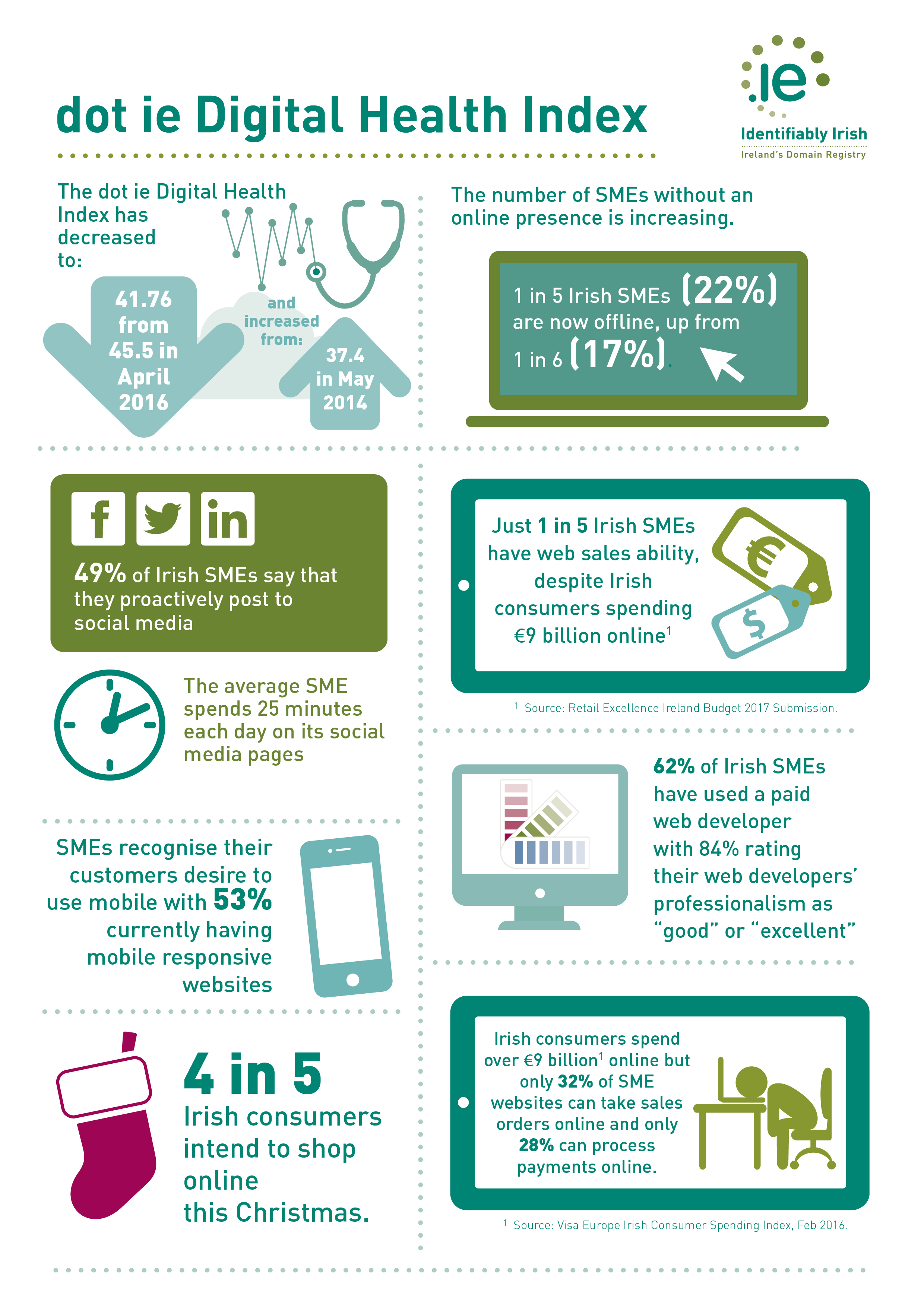IEDR have released an update to their “dot ie Digital Health Index”.
The full report, which runs to about 60 pages, is summarised in their accompanying press release and graphic:
Here’s the full press release:
Less than a third of Irish SMEs’ websites are ‘e-commerce enabled’ even as Irish consumers are set to spend in excess of €100 million online this Black Friday and Cyber Monday*, according to the latest ‘dot ie Digital Health Index’ report** by the .ie Domain Registry (IEDR), the company that manages Ireland’s national domain name.
The research shows that just 32% of SMEs can take sales orders on their websites; only 28% can process payments; and 35% can accept bookings or reservations on their websites.
While these numbers have increased slightly since the last dot ie Digital Health Index report in April 2016, they suggest that Irish SMEs are still not tapping into the growing Irish e-commerce market valued at €9 billion this year. There is a degree of ‘cognitive dissonance’ at play. Despite their lack of e-commerce ability, 81% of SMEs say that their website is important or very important for driving future sales growth; 77% as a driver of generating sales; and 57% as a point of transaction to capture and process sales.
IEDR’s consumer research revealed an increasing willingness to spend online. Consumers reported that their online spend has increased by 41% over the last two years. 86% plan to spend online over the Christmas period; 85% would prefer to spend on an Irish website. However, Irish SMEs’ low engagement in e-commerce makes this difficult.
The overall dot ie Digital Health Index score fell for the first time since research began in May 2014, to 41.76, the second lowest score. In many cases, SMEs are using fewer digital assets, like websites and social media.
“What’s stopping SMEs getting online?” and further insights
The report revealed that 1 in 5 or 22% of SMEs have no online presence whatsoever. 38% say that a lack of time is keeping them offline and 28% a lack of expertise; 27% cite financial constraints and 16% are concerned about cybersecurity.
1 in 6 offline SMEs, or 17%, say a poor internet connection is preventing them going online.
Surprisingly, a massive two thirds, 66%, of offline SMEs say they do not intend to build a website in the future, primarily because they see “no need” in their industry.
Despite anecdotal evidence suggesting that SMEs have a negative or costly experience building websites, the research found that of those who used a professional developer, 84% rated their developer’s professionalism as ‘good’ or ‘excellent’.
On social media usage by SMEs, the research also revealed:
- 72% of SMEs report a positive impact from social media; of that figure, 97% said it had increased awareness of their business and 81% said it had increased (offline) sales.
- The average SME spends 25 minutes each day on its social media pages, meaning more time spent interacting with customers and promoting their business.
Comment
Commenting on the dot ie Digital Health Index’s findings, David Curtin, Chief Executive of IEDR, said: “It is alarming that in 2016, only one third of SMEs can sell or take payments online. The failure to properly tap into the growing €9 billion online market may have long-term consequences for Ireland’s economy, particularly for rural communities given their significant dependence on SMEs.
“If consumers build a relationship with British online SMEs, the business may be irretrievable for Irish SMEs. This issue will be exacerbated by Brexit, with Irish consumers migrating to sterling-based websites and travelling across the border for a better shopping experience.
“As consumers, we are spending more on the internet than ever before, yet our own businesses just aren’t there to serve customers. With Christmas less than a month away, and an appetite among Irish consumers to spend locally, SMEs are missing out on new customers. “1 in 5 Irish SMEs have no online presence whatsoever. Unsurprisingly, the biggest barrier to SMEs getting online is a ‘lack of time’ and ‘lack of finance’. This is a shame, however, because these problems can be easily addressed; there are plenty of inexpensive, easy-to-use tools that put together websites with basic e-commerce functionality in a few hours or less.
“However, there are infrastructural deficiencies and business support issues that can only be properly fixed through collaboration between industry and government, particularly broadband availability. Funding also needs to be directed to Local Enterprise Offices and Chambers of Commerce in rural areas to support entrepreneurs making the leap online.
“IEDR calls on government to work with e-commerce stakeholders and to provide more supports to hard-pressed small business owners; improving access to digital skills training and practical workshops on e-commerce is particularly important. There is ample evidence that mentoring and shoulder-to-shoulder assistance is very effective in delivering tangible benefits for digital newcomers.”
You can read more details in the full report:
[spiderpowa-pdf src=”https://www.internetnews.me/wp-content/uploads/2016/11/dot-ie-Digial-Health-Index-Q4-2016.pdf”]dot-ie-digial-health-index-q4-2016
Personally I disagree with IEDR’s focus and tone completely. The emphasis on e-commerce is, in my opinion, ill placed and the focus should really be on getting small businesses to embrace online in general. Not all businesses need to sell online, though they all need an online presence for lead generation and other business activity. And what about email addresses? The number of small businesses that advertise Eircom / Gmail / Hotmail instead of their own business is frightening!
